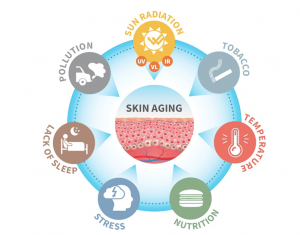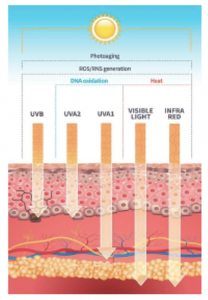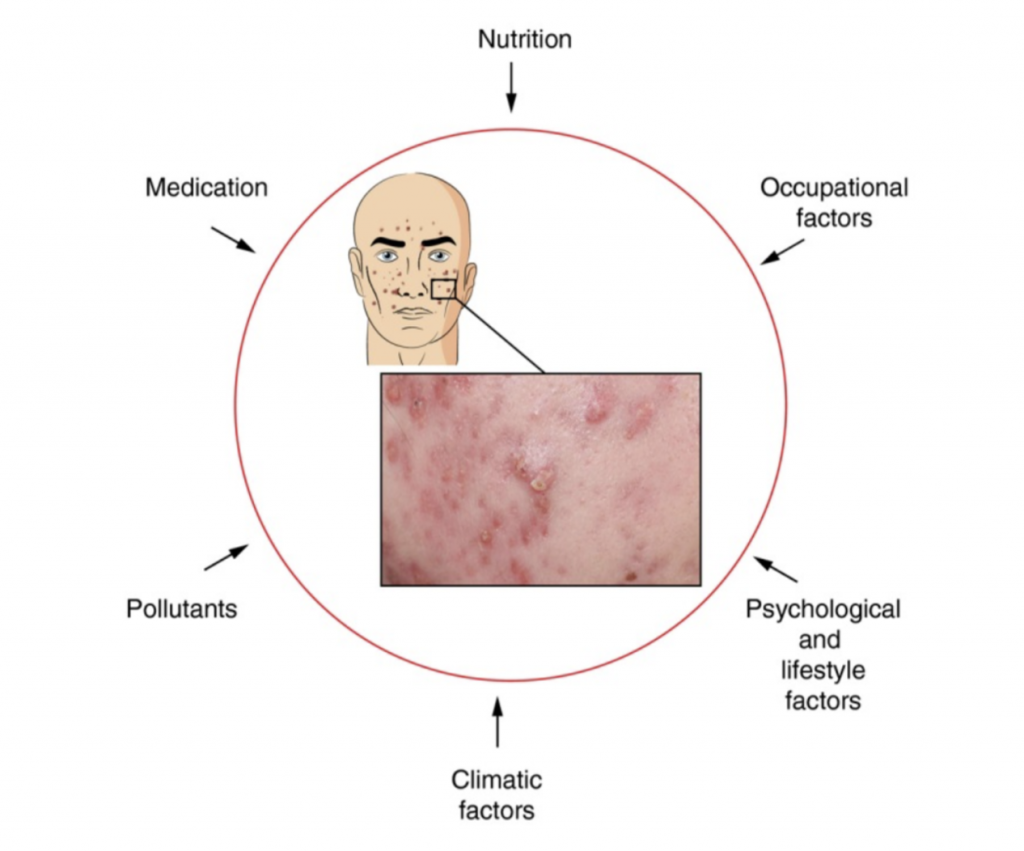In the last two decades the role of antioxidants in skin care has radically changed. In the early 2000s, it was typical to find finished formulas on the shelf that contained butylated hydroxytoluene (BHT) or butylated hydroxyanisole (BHA), which were mostly added to enhance the shelf-life of the product. As time went on, formulas containing vitamin C and vitamin E (alpha-tocopherol) became more common since many studies carried out during that period demonstrated the invaluable benefits provided to the skin by these antioxidants.
As the personal care industry entered the end of the first decade in the new millennium, naturally derived ingredients started to become more and more common. Of course, most of these ingredients were based on botanical ingredients, which are chock-full of polyphenols and other ingredients with antioxidant properties. Antioxidants have also become key components of sunscreen formulas, as research demonstrated unique benefits from the addition of antioxidants in addition to any UV absorption properties. Further, a great deal of research has gone into delivery systems for antioxidants, which provide targeted delivery and stability for antioxidants. Nowadays, one can find antioxidants in just about every type of skin care product in the marketplace. In this article, we will review some of the latest advances in antioxidant technology in the skin care arena.
Skin Protection by Antioxidants from Natural Sources
Topical and oral administration of antioxidants for the skin is still a very active field of research [1]. In the personal care industry and academia, a great deal of understanding has been accomplished in the area of topical antioxidant treatments. There are a host of different molecules that have proven to be efficacious for the protection of skin. Some of the most commonly studied antioxidants for topical skin treatment consist of ascorbic acid (vitamin C), alpha-tocopherol (vitamin E), and catechins from green tea. Some other popular ingredients include lycopene, carotene, genistein, rutin, and caffeine [2].
In recent years, most of the focus on new antioxidant product development has been in the botanical arena [1, 3, 4]. Phytochemicals are molecules that are produced by plants. Much effort has gone into understanding their antioxidant, anti-inflammatory, and anti-carcinogenic potential for skin care. There are several recent examples in the literature where the biological activity (antioxidant properties) of botanical ingredients applied to the skin or in cell culture is demonstrated (see Table 1).
Table 1. Examples of studies utilizing botanical ingredients for the treatment of skin.
| Source | Key Components | Efficacy Measurements | Reference |
| Moringa oleifera seed oil | Alpha-tocopherol; plant sterols; fatty acids | DPPH free radical scavenging assay; skin hydration, erythema melanin values, and elasticity | [5] |
| Brown algae | Laminarin (polysaccharide) | Collagen fiber density, superoxide production, and expression of antioxidant enzymes in UVB-exposed murine skin | [6] |
| Hibiscus syriacus L. (Malvaceae) | Anthocyanin-enriched polyphenols | UVB-induced apoptosis, endoplasmic reticulum stress, and mitochondrial reactive oxygen species in HaCaT keratinocytes | [7] |
| Fermented Yak-Kong (a small black soybean) | Phenolic acids, isoflavones, and proanthocyanidins | Effect of UV exposure on: in vivo wrinkle formation; MMP-1, AP-1, ERK1/2, and JNK1/2 activity in HaCaT keratinocytes; and degradation of collagen in a 3D skin model | [8] |
In some cases, natural ingredients have a limited shelf life or are not stable in different formulation chassis. As such, synthetic ingredients are often inspired by nature. A recent example in the personal care industry is acetyl zingerone, which is structurally similar to zingerone found in the root of the ginger plant, Zingiber officinale [9]. Aguirre-Cruz et al. recently demonstrated the antioxidant potential of peptides, specifically hydrolyzed collagen, to protect the skin from environmental stress [10]. The precise mechanism in which peptides act as antioxidants is not known; however, proton (or electron) donation is suspected to play a role.
In the last decade a tremendous amount of research has been conducted to determine the benefits of molecules from cannabis—a genus of plants from the cannabaceae family. There are a number of phytocannabinoids that have been identified from the hemp plant; however, cannabidiol (CBD) is one of the most studied molecules. Baswan et al. provide a comprehensive review of work conducted in relation to the topical treatment of skin with CDB [11]. It was proposed that CDB has potential to treat eczema, psoriasis, pruritis, and inflammatory conditions.
In addition to topical application, antioxidants and other essential nutrients obtained through the diet (oral consumption) play an integral role in the health state of the skin. This is especially true in regard to moisturization, care of aging skin, and protection against the effects of UV radiation. Many of these key dietary components consist of: omega-3 and omega-6 fatty acids; vitamins A, C, and E; carotenoids; polyphenols; and selenium, zinc, and copper [12].
Antioxidant Delivery Systems
Some of the challenges with the conventional delivery of antioxidants stems from their poor solubility, limited shelf-life stability, compromised photostability, and low degree of skin permeability. Delivery systems enhance the ability of antioxidants to carry out their biological function. Various types of emulsion, vesicular, lipid particle, nanoparticle, and nanocarrier systems have been studied and developed in recent years to aid in the stabilization and delivery of antioxidants to the skin.
Emulsions are dispersions of oil and water and can refer to microemulsions, nanoemulsions, and Pickering emulsions. Vesicular systems consist of liposomes, phytosomes, transferomes, ethosomes, and niosomes. Liposomes are the most popular vesicular system used in personal care applications and are composed of concentric layers of phospholipid bilayers spherically shaped with a hollow center for the active ingredient. Barba and coworkers developed nanoliposomes containing vitamin D3, vitamin K2, vitamin E, and curcumin for topical delivery [13]. On their own, these ingredients are unstable and do not penetrate into the skin very well.
Lipid particle systems consist of lipid microparticles and lipid nanoparticles. A recent study showed the utility of caffeic acid lipid nanoparticulate systems for applications in skin [14]. Nanoparticles and nanocarriers continue to be at the forefront of skin care research for their potential at stabilizing and delivering antioxidants to the skin. For example, gold nanoparticles are known for their anti-inflammatory, antiaging, and wound healing properties in skin care [15, 16]. Nanoencapsulation is another area that shows promise for the delivery of lipid soluble antioxidants to the skin [17].
Sunscreen Technologies Based on Antioxidants
Exposure of skin to UV radiation can cause direct damage to cellular DNA by crosslinking (UVB) or indirect DNA damage caused by photosensitization reactions (UVA). Photosensitization can occur due to the presence of endogenous (e.g., chromophores in proteins) or exogenous (e.g., UVA sunscreens) species in/on the skin. Almost twenty years ago, Hanson and Clegg demonstrated that sunscreen photoprotection could be enhanced if antioxidants were included in the formula [18]. This has become such an important area of research that the Journal of Photochemistry and Photobiology has recently announced that it will dedicate a special issue to the topic of endogenous photosensitizers and their roles in skin photodamage and photoprotection.
The majority of commercial sunscreen formulas contain antioxidants [1]. In part, this is due to the popularity of including botanical ingredients in skin care products. However, the presence of antioxidant species can ameliorate damage caused during and after sun exposure by reactive oxygen species. A recent review by Giacomoni presents this case in relation to the activity of molecules capable of impeding the damaging effects of superoxide anion and singlet oxygen [19].
Concluding Remarks
In the last several years, there has been significant progress in the scientific understanding of antioxidant treatment of the skin. Everly increasing numbers of studies of new ingredients continue to appear in the literature. Hopefully, in the years to come there will be some type of method harmonization across institutes and industry to more uniformly characterize antioxidant behavior from the vast array of botanical ingredients. Many antioxidants are unstable or not easily bioavailable after treatment. To circumvent these challenges, antioxidant delivery systems have been developed and show much promise in the future. Finally, antioxidants play an integral role in sun protection. They are incorporated into sunscreen formulas for their ability to ameliorate damage induced by reactive oxygen species resulting from exposure to UV radiation.
References
- McMullen, R., Antioxidants and the Skin. 2nd ed. 2019, Boca Raton, FL: CRC Press.
- Azevedo Martins, T.E., C.A. Sales de Oliveira Pinto, A. Costa de Oliveira, M.V. Robles Velasco, A.R. Gorriti Guitiérrez, M.F. Cosquillo Rafael, J.P.H. Tarazona, and M.G. Retuerto-Figueroa, Contribution of topical antioxidants to maintain healthy skin—A review. Scientia Pharmaceutica, 2020. 88(2): p. 27.
- Herranz-López, M. and E. Barrajón-Catalán, Antioxidants and skin protection. Antioxidants, 2020. 9: p. 704.
- Petruk, G., R. Del Giudice, M.M. Rigano, and D.M. Monti, Antioxidants from plants protect against skin photoaging. Oxid. Med. Cell. Longev., 2018. 2018: p. 1454936.
- Athikomkulchai, S., P. Tunit, S. Tadtong, P. Jantrawut, S. Sommano, and C. Chittasupho, Moringa oleifera seed oil formulation physical stability and chemical constituents for enhancing skin hydration and antioxidant activity. Antioxidants, 2021. 8(1): p. 2.
- Ahn, J., D. Kim, C. Park, B. Kim, H. Sim, H. Kim, T.-K. Lee, J.-C. Lee, G. Yang, Y. Her, J. Park, T. Sim, H. Lee, and M.-H. Won, Laminarin attenuates ultraviolet-induced skin damage by reducing superoxide anion levels and increasing endogenous antioxidants in the dorsal skin of mice. Mar. Drugs, 2020. 18: p. 345.
- Karunarathne, W., I. Molagoda, K. Lee, Y. Choi, S.-M. Yu, C.-H. Kang, and G.-Y. Kim, Protective effect of anthocyanin-enriched polyphenols from Hibiscus syriacus L. (Malvaceae) against ultraviolet B-induced damage. Antioxidants, 2021. 10: p. 584.
- H, P., S. JW, L. TK, K. JH, K. JE, L. TG, P. JHY, H. CS, Y. H, and L. KW, Ethanol extract of yak-kong fermented by lactic acid bacteria from a Korean infant markedly reduces matrix metallopreteinase-1 expression induced by solar ultraviolet irradiation in human keratinocytes and a 3D skin model. Antioxidants, 2021. 10(2): p. 291.
- Chaudhuri, R., T. Meyer, S. Premi, and D. Brash, Omni antioxidant: Acetyl zingerone scavenges/quenches reactive species, selectively chelates iron. Int. J. Cosmet. Sci., 2020. 42: p. 36-45.
- Aguirre-Cruz, G., A. León-López, V. Cruz-Gómez, R. Jiménez-Alvarado, and G. Aguirre-Álvarez, Collagen hydrolysates for skin protection: Oral administration and topical formulation. Antioxidants, 2020. 9(2): p. 181.
- Baswan, S., A. Klosner, K. Glynn, A. Rajgopal, K. Malik, S. Yim, and N. Stern, Therapeutic potential of cannabidiol (CBD) for skin health and disorders. Clin. Cosmet. Investig. Dermatol., 2020. 13: p. 927-942.
- Michalak, M., M. Pierzak, B. Kręcisz, and E. Suliga, Bioactive compounds for skin health: A review. Nutrients, 2021. 13: p. 203.
- Bochicchio, S., A. Dalmoro, V. De Simone, P. Bertoncin, G. Lamberti, and A.A. Barba, Simil-microfluidic nanotechnology in manufacturing of liposomes as hydrophobic antioxidants skin release systems. Cosmetics, 2020. 7(2): p. 22.
- Hallan, S., M. Sguizzato, M. Drechsler, P. Mariani, L. Montesi, R. Cortesi, S. Björklund, T. Ruzgas, and E. Esposito, The potential of caffeic acid lipid nanoparticulate systems for skin application: In vitro assays to assess delivery and antioxidant effect. Nanomaterials, 2021. 11(1): p. 171.
- Ben Haddada, M., E. Gerometta, R. Chawech, J. Sorres, A. Bialecki, S. Pesnel, J. Spadavecchia, and A.-L. Morel, Assessment of antioxidant and dermoprotective activities of gold nanoparticles as safe cosmetic ingredient. Colloid. Surface. B, 2020. 189: p. 110855.
- Gubitosa, J., V. Rizzi, P. Fini, R. Del Sole, A. Lopedota, V. Laquintana, N. Denora, A. Agostiano, and P. Cosma, Multifunctional green synthetized gold nanoparticles/chitosan/ellagic acid self-assembly: Antioxidant, sun filter and tyrosinase-inhibitor properties. Mater. Sci. Eng. C, 2020. 106: p. 110170.
- Davies, S., R.V. Contri, S.S. Guterres, A.R. Pohlmann, and I.C.K. Guerreiro, Simultaneous nanoencapsulation of lipoic acid and resveratrol with improved antioxidant properties for the skin. Colloid. Surface. B, 2020. 192: p. 111023.
- Hanson, K. and R. Clegg, Bioconvertible vitamin antioxidants improve sunscreen photoprotection against UV-induced reactive oxygen species. J. Cosmet. Sci., 2003. 54(6): p. 589-598.
- Giacomoni, P., Appropriate technologies to accompany sunscreens in the battle against ultraviolet, superoxide, and singlet oxygen. Antioxidants, 2020. 9: p. 1091.

Roger L. McMullen, Ph.D.
Dr. Roger McMullen has over 20 years of experience in the personal care industry with specialties in optics, imaging, and spectroscopy of hair and skin. Currently, he is a Principal Scientist at Ashland Specialty Ingredients G.P. and leads the Material Science team in the Measurement Science department. Roger has over 30 publications in peer-reviewed journals and textbooks. He is also the author of Antioxidants and the Skin, 2nd edition and founded the online news magazine The Cosmetic Chemist. Roger received a B.S. in Chemistry from Saint Vincent College and completed his Ph.D. in Biophysical Chemistry at Seton Hall University.
Roger actively engages and participates in educational activities in the personal care industry. He frequently teaches continuing education courses for the SCC and TRI-Princeton. In addition, Roger is an Adjunct Professor at Fairleigh Dickinson University and teaches Biochemistry to students pursuing M.S. degrees in Cosmetic Science and Pharmaceutical Chemistry. Prior to pursuing a career in science, Roger served in the U.S. Navy for four years on board the USS YORKTOWN (CG 48). He is fluent in Spanish and Catalan and currently is learning to play the classical guitar.










